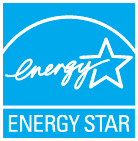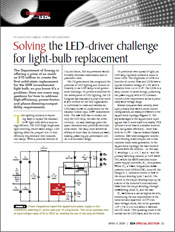Nowadays there is ENERGY STAR rating for solid state lamps in USA. Solid-state lighting (SSL) products that meet efficiency and performance criteria set by the U.S. Department of Energy can earn the ENERGY STAR. For more details refer to the ENERGY STAR Requirements for SSL Luminaires. In December 2009, DOE published ENERGY STAR criteria for integral LED lamps, which go into effect in August 2010.

Energy efficiency is a talked about a lot. The Department of Energy is offering a prize of as much as $10 million to create the first solid-state replacement for the 60W incandescent light bulb, so you know it’s a problem. Solving the LED-driver challenge for light-bulb replacement article offers some suggestions for how to address high-efficiency, power-factor, and phase-dimming-compatibility requirements.

When designing LED lamps you need to take into account the heat generated by the LED. Most of the electricity that goes to LED still gets converted to head instead of light, and you need to get rid of it in some way. Light-emitting diodes (LEDs) don’t like heat. Heat shortens their lifetimes. With LED power levels rising, engineers need to find new ways to dissipate heat or use the old ways better. Dealing with LED Heat discusses on the issues hot to get rid of the heat generated by high power LED. Incandescent bulbs eliminate their heat through radiation, whereas with LEDs it’s more of a mechanical issue.
3 Comments
Maybell Happe says:
I would just go and ask them if they could turn the light off at night. It’s feasible they don’t consider anything of it and would turn it suitable off.
If it is an inconvenience for them or they have a decent reason, because it is their proper you must go and get a sleeping mask so the lighting doesn’t bother you or save up for blackout curtains.
Tomi Engdahl says:
Samsung turns off lights on LEDs worldwide – except in South Korea
Not the bright future Sammy was imagining
http://www.theregister.co.uk/2014/10/27/samsung_scales_back_leds_to_korea/
Samsung has decided to stop pushing its light emitting diode business outside of South Korea, despite reckoning it would be a growth area a few years ago.
Like Philips, Sammy has realised that LED is not, after all, where it’s at, and it will be shutting the unit down overseas.
Philips recently announced it would be spinning off the majority of its lighting business, which has been around for over a hundred years, into a separate company. The firm is only hanging onto large, complex lighting systems, spinning LEDs off after a price war in the sector left profit margins looking a bit slim.
Tomi Engdahl says:
Designing LEDs for hazardous environments
https://www.edn.com/electronics-blogs/led-diva/4458944/Designing-LEDs-for-hazardous-environments
The conversion to LED lighting is happening everywhere, and hazardous environment facilities like oil rigs and heavy manufacturing are no exception. Designing LED lighting systems for these environments poses a special challenge in making sure that the products hold up under extreme temperatures and exposure to highly corrosive airborne chemicals. So what makes a successful hazardous-environment LED lighting product? To find out, I asked John Peck, Dialight’s VP of Engineering. Dialight began its foray into LED lighting with panel indicators, and now offers a full line of LED lighting for hazardous environments.